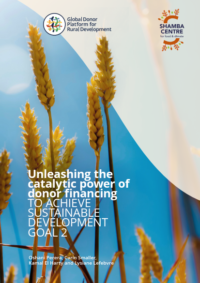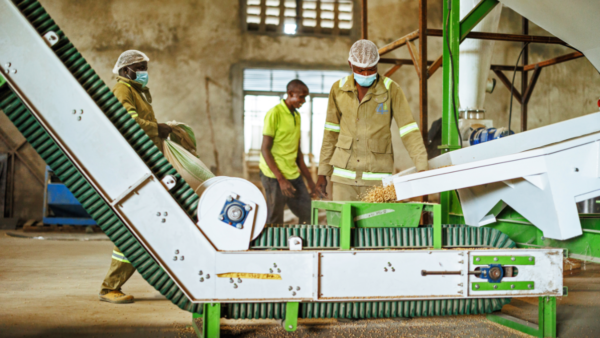This report is dedicated to bilateral and multilateral donors engaging in blended finance, who aim to boost access to commercial finance by agrifood small and medium enterprises (SMEs). The investigation included a series of interviews which explored how donors, philanthropic organizations, public funds and blended capital funds can make their funding effective and act as an incentive for achieving SDG 2.
The report shows the risk appetite of donors and DFIs is on the rise. This is a unique opportunity for donors, DFIs and their beneficiaries in developing countries to make widespread changes by implementing the recommendations of this report.
The 2023 State of the Sector report shares market insights drawing upon quantitative and qualitative input from 20 financial institutions and provides a deeper analysis of the risks agri-SMEs and lenders face, and how agricultural lenders can respond.
Four key findings and recommendations are presented from the Donor Platform and Shamba Centre for Food & Climate's 2023 enquiry.
The report’s central message shows the catalytic power of aid. If donors and development finance institutions (DFIs) take higher risks with their grants and lending, every donor dollar has the potential to mobilize four dollars in commercial finance. When this happens, agrifood SMEs will have more financing, domestic lenders will participate, and markets will deliver affordable borrowing prices.
Read the report.
The report’s central message shows the catalytic power of aid. If donors and development finance institutions (DFIs) take higher risks with their grants and lending, every donor dollar has the potential to mobilize four dollars in commercial finance. When this happens, agrifood SMEs will have more financing, domestic lenders will participate, and markets will deliver affordable borrowing prices.
Read the report.
Key findings and recommendations
Key finding 1: Blended finance can make the biggest contribution to SDG 2 by focusing on the missing middle: agrifood SMEs seeking finance of between US$50,000 and US$2 million
- Key recommendation 1: Donors and DFIs can increase the flow of finance to agrifood SMEs by:
- building the agrifood expertise and risk appetite of domestic lenders, including developing an agrifood credit risk assessment scorecard, as proposed by the United Nations Economic Commission for Africa;
- scaling up priority lending programmes and results-based lending incentives for domestic banks, encouraging them to use their own balance sheets to lend to agrifood SMEs;
- increasing finance for affordable, indemnity-based, weather-indexed and crop-indexed insurance;
- incorporating bookkeeping and accounting skills into SME technical assistance programmes.
Key finding 2: Every dollar of concessional finance can mobilize four dollars of commercial finance; however, whether those four dollars deliver a sustainable development impact will determine if blended finance can bring not only financial additionality but also development additionality.
- Key recommendation 2: Donors and the wider blended finance community can expand the pool of blended finance by:
- reducing transaction costs related to the exploration, negotiation and conclusion of blended finance transactions;
- exploring how donors can provide not only first-loss financing but also lending at commercial rates, where returns on these investments can be ring-fenced for reinvestment into the same or other blended transactions;
- continuing to provide grants for technical assistance for SMEs and domestic lenders, as they bring high levels of financial and development additionality;
- sharing data, reducing transaction costs and collaborating on cofinancing through the creation of a multi-donor working group, supported by a sustainable finance knowledge hub.
Key finding 3: DFIs are governed by rules that discourage them from taking risks to provide finance that would otherwise not be available from commercial lenders.
- Key recommendation 3: Donor governments must provide DFIs with dedicated funds that allow them to:
- offer higher-risk loans, such as first loss and mezzanine debt, that have well-defined targets on sustainable food and agriculture;
- provide long-term credit lines, guarantees, transaction advice and technical assistance to domestic financial institutions to build institutional knowledge on sustainable agrifood systems.
- Key recommendation 4: Donors should create a data repository on the performance of agrifood SME loans, building on the experience of the Council on Smallholder Agricultural Finance (CSAF) and MIX Market.
Extracts of this report
- In 2022, lenders from CSAF primarily directed their lending to cash crop value chains (CSAF, 2023a). Agrifood SMEs and farmers’ organizations involved in coffee, cocoa, cashew nuts, soya beans and quinoa received most of the loans, with only 24 per cent going to value chains of other crops for domestic consumption in 2022. (page 12)
- Aceli Africa provides results-based financial incentives to domestic lenders in Kenya, Rwanda, the United Republic of Tanzania, and Uganda. In the absence of these incentives, local lenders would not be lending to agrifood SMEs. The incentives are designed based on lending data from 31 financial institutions, including local banks, international social lenders and members of CSAF. (...) Aceli Africa’s budget for 2020–2025 is US$75 million, more than 50 per cent of which is used to provide incentives. As of October 2023, Aceli Africa’s incentives had supported 1,404 loans totaling US$142 million (60 per cent of loans to first-time borrowers). (page 17)
- In September 2023, the United States Agency for International Development (USAID) and the Norwegian Agency for Development Cooperation, each with a preliminary contribution of US$35 million, launched the FASA Fund to increase financing for smallholder farmers and agricultural SMEs in Africa with financing needs of between US$200,000 and US$5 million. The initial commitments from USAID and the Norwegian Agency for Development Cooperation are expected to attract additional contributions from other donors totaling US$200 million. (...) The US$200 million donor contribution is expected to unlock US$1 billion in commercial financing. (... ) The US$1 billion of commercial financing mobilized is expected to support 500 agrifood SMEs, create 60,000 private sector jobs, benefit 1.5 million smallholder farmers and positively affect about 7.5 million people. (page 22)
- Africa Improved Foods is a social enterprise producing affordable fortified foods for pregnant and lactating women and for infants. It was established in 2015 as a joint venture between the Agaciro Development Fund, Royal DSM, FMO, the Dutch entrepreneurial development bank, the Department for International Development Impact Acceleration Facility managed by the CDC Group and the International Finance Corporation (FMO, n.d.). (page 25)
Related:
CSAF (2023) Closing the Gender Gap in Agricultural Investments: How Three CSAF Investors Are Turning Gender Intention Into Action. # 28 p.
The report features case studies on Incofin, Alterfin, and Cordaid Investment Management, three impact investors who were able to successfully turn their gender intentions into action by focusing on the Gender Lens Investing (GLI) strategies most aligned with their business and impact priorities.
Root Capital, in collaboration with Value for Women and CSAF, provided comprehensive GLI training to these three investors as part of the "Strengthening the Livelihoods of Women Smallholders through Investments in Gender-Inclusive and Women-Led Agricultural Businesses project". The project aims to establish a replicable model and evidence base for other donors and investors to adopt GLI practices.
Extracts of this report
- Over 65% of women in certain regions such as sub-Saharan Africa and South Asia earn their living from the agriculture sector. Yet, women receive only 7% of total agricultural investment. (...)
- On average, women-led enterprises experience year-on-year growth rates of 25.7% CAGR (compound annual growth rate) and 45.2% AAGR (average annual growth rate). Gender inclusive businesses experience, on average, year-on-year growth rates of 20.6% (CAGR) and 35.1% (AAGR). (page 6)
CSAF (2023) 2023 State of the Sector # 26 p.
The 2023 State of the Sector report shares market insights drawing upon quantitative and qualitative input from 20 financial institutions and provides a deeper analysis of the risks agri-SMEs and lenders face, and how agricultural lenders can respond.
In 2022, CSAF members issued loans totaling $750 million to over 650 businesses across 59 countries. Lenders sustained high volumes of lending following a year of significant growth, though there were large variances across regions, and sustained high additionality despite an increasingly maturing agri-SME finance market.
- Executive Summary
- Full report Download View PDF
- watch the webinar recording for further discussion of the insights.
- CSAF lenders disbursed $750M in 2022 to over 650 businesses across nearly 60 countries. (2013–2022: $6.2B)
- The sector needs to constantly be innovating new tools, subsidies, and blended finance structures to mitigate those risks and continue to deliver impact for agri-SMEs.
- Sub-Saharan Africa remained the largest destination for CSAF member financing, but experienced negligible growth in 2022. (page 17)
- Coffee continues to comprise the majority of CSAF member lending activity, reaching an all-time high in 2022
- Cocoa lending reverted to 2020 levels, driven predominantly by lower activity in Côte d’Ivoire and Ghana.
- Macadamia lending. After a couple of years of a steady downward trend, disbursement to tree nut enterprises grew significantly in 2022. Driven primarily by an increase to macadamia processors in Kenya of $16M, nut disbursements returned to 2019 levels.





No comments:
Post a Comment